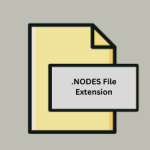.RMI File Extension

RMID MIDI File
| Developer | N/A |
| Popularity | |
| Category | Audio Files |
| Format | .RMI |
| Cross Platform | Update Soon |
What is an RMI file?
The .RMI file extension is associated with files that contain data in the Resource Interchange File Format (RIFF). RIFF is a generic file container format that can store various types of data, including audio, video, and multimedia content. The .RMI extension specifically refers to files that contain MIDI (Musical Instrument Digital Interface) data.
More Information.
The initial purpose of the .RMI file extension was to enable the storage and playback of MIDI sequences within multimedia presentations and applications. Microsoft recognized the growing importance of multimedia content and sought to establish a file format that could efficiently handle MIDI data, which was widely used for musical compositions and arrangements.
Origin Of This File.
The .RMI file format was developed by Microsoft and was first introduced as part of the Windows 3.1 operating system in the early 1990s. The purpose of creating .RMI files was to provide a standardized way of storing and exchanging MIDI data, allowing for the seamless integration of MIDI files into multimedia applications.
File Structure Technical Specification.
The .RMI file follows the RIFF file format structure, which consists of various chunks of data. The key components of an .RMI file include the header chunk, the data chunk, and the list chunk.
The header chunk contains essential information about the file, such as the type of data stored and the file size.
The data chunk holds the actual MIDI data, while the list chunk may include additional information or sub-chunks.
Technical specifications for the .RMI file format are detailed in the Microsoft RIFF MIDI file specification, providing developers with guidelines on how to create, read, and manipulate .RMI files.
How to Convert the File?
Windows:
Using Windows Media Player:
- Open Windows Media Player on your Windows system.
- Navigate to the “File” menu and select “Open” to browse for the .RMI file.
- Windows Media Player natively supports .RMI files, allowing for playback without the need for conversion.
Third-Party Conversion Tools:
- Download and install a third-party audio conversion tool compatible with Windows, such as Audacity or Format Factory.
- Open the conversion tool and import the .RMI file.
- Choose the desired output format (e.g., MP3, WAV) and initiate the conversion process.
Linux:
Using Timidity++:
- Ensure Timidity++ is installed on your Linux system. If not, install it using your package manager.
- Open the terminal and use the command line to navigate to the directory containing the .RMI file.
- Use the command timidity filename.rmi to play the .RMI file or timidity -Ow filename.rmi to convert it to WAV format.
Mac:
Using GarageBand:
- Open GarageBand on your Mac.
- Create a new project or open an existing one.
- Drag and drop the .RMI file into GarageBand.
- GarageBand will automatically convert the .RMI file, allowing for playback and further editing.
Android:
MIDI Apps:
- Visit the Google Play Store and search for MIDI player apps, such as “MIDI Melody.”
- Download and install a MIDI player that supports the .RMI file format.
- Open the app and use it to play .RMI files on your Android device.
iOS:
Using GarageBand for iOS:
- Open GarageBand on your iPhone or iPad.
- Create a new project or open an existing one.
- Import the .RMI file into GarageBand.
- GarageBand for iOS will automatically handle the conversion, enabling playback and editing.
Advantages And Disadvantages.
Advantages:
- Cross-Platform Compatibility: .RMI files can be played on various platforms that support MIDI playback.
- Compact File Size: The RIFF format allows for efficient compression of MIDI data, resulting in relatively small file sizes.
- Widespread Support: Many multimedia applications and music software packages support the .RMI file format.
Disadvantages:
- Limited Use: The .RMI format is primarily designed for MIDI data, limiting its use to audio-related applications.
- Obsolete in Some Contexts: As technology has evolved, the use of .RMI files has diminished in favor of more modern and versatile formats.
How to Open RMI?
Open In Windows
- Using Media Player: Windows Media Player natively supports .RMI files. Simply open the file using the player.
- Conversion Tools: Use third-party conversion tools compatible with Windows to convert .RMI to more common audio formats.
Open In Linux
Timidity++: Utilize Timidity++ to play .RMI files on Linux systems. Install Timidity++ and use the command line to play or convert .RMI files.
Open In MAC
GarageBand: Mac users can open .RMI files in GarageBand, a digital audio workstation. Simply import the file into GarageBand for playback or conversion.
Open In Android
MIDI Apps: Numerous MIDI-compatible apps on the Google Play Store allow users to play .RMI files on Android devices.
Open In IOS
GarageBand for iOS: Similar to the Mac version, GarageBand for iOS can be used to open and play .RMI files on iPhones and iPads.
Open in Others
Cross-Platform Media Players: Use versatile media players like VLC that support .RMI files across different operating systems.













